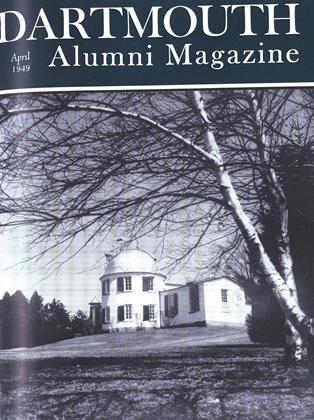W. Elderkin '02. Pond-Ekberg, Springfield,1941-1948, 411 pp., $11.00.
Professor Elderkin has written for the specialist, but his erudition is conspicuous for clear expression, broad interest, and keen reasoning leading to solid conclusions of lasting importance; any reader worthy of the name will find pleasure and profit in such work as this. The 24 studies comprised in the 10 fascicules of the volume range in length from 4 to 69 pages, in period from early Minoan to late Hellenistic, and cover in locale the greater part of the ancient civilized world. Significant examples of the architecture, sculpture, painting, and other arts of Crete, Greece, Etruria, and other regions are discussed as works of art and interpreted in relation to the civilizations which created them. The ninety illustrations are well selected; the bibliographical notes are plentiful; the printing is excellent.
This volume is sure to enhance the reputation of an author already favorably known for the value and variety of his previous contributions to archaeological knowledge. The present work seems particularly rich in its profuse references to the myths, religious usages, social customs, literary forms, artistic symbols, and other aspects of ancient life which are (as should really be obvious but apparently is not) fundamental for any detailed understanding of Western Cvilization in any period and at any level. If one, for instance, does not know such simple things as exactly why a bronze pine-cone three meters high, the mystic symbol of Dionysus, should now be standing in the gardens of the Vatican, or why the Holy Sepulchre was designed as a labyrinthine maze, or even why the Dartmouth year-book is called the Aegis, Professor Elderkin, although this is not his primary purpose in writing, will tell him.
 View Full Issue
View Full Issue
More From This Issue
-
 Article
ArticleTHE ARCTIC
April 1949 By TREVOR LLOYD, -
 Article
ArticleConcerning Admissions
April 1949 By H. CLIFFORD BEAN '16 -
 Lettter from the Editor
Lettter from the EditorLetter from Oxford
April 1949 By CHARLES G. BOLTE '41 -
 Class Notes
Class Notes1918
April 1949 By ERNEST H. EARLEY, DONALD L. BARR, RICHARD A. HOLTON -
 Article
ArticleDeaths
April 1949 -
 Class Notes
Class Notes1929
April 1949 By F. WILLIAM ANDRES, EDWIN C. CHINLUND, GEORGE B. REDDING
Books
-
 Books
BooksAlumni Publications
November 1944 -
 Books
BooksWings
June 1980 By Everett Wood ’38 -
 Books
BooksTHE BULLS AND THE BEARS: HOW THE STOCK EXCHANGE WORKS.
DECEMBER 1967 By JOHN HURD '21 -
 Books
BooksVice in Its Gayest Colors
June 1975 By JOHN HURD '21 -
 Books
BooksJOURNEY ALL ALONE.
NOVEMBER 1971 By ROBERT F. HAUGH -
 Books
BooksFROM WHENCE COMETH MY HELP
March 1940 By Roy B. Chamberlin

